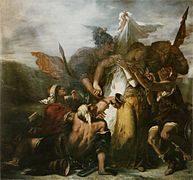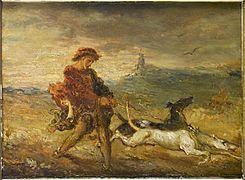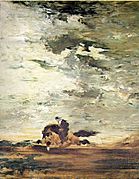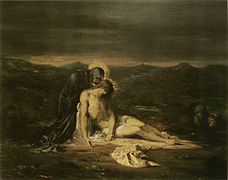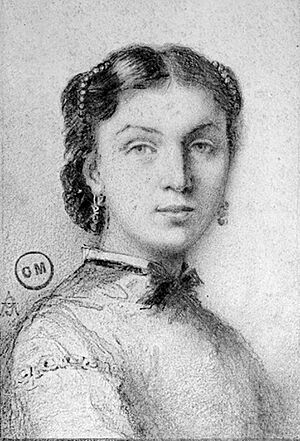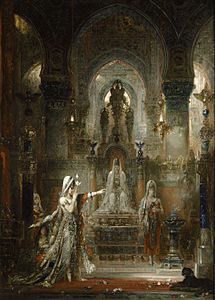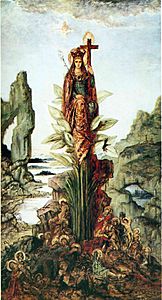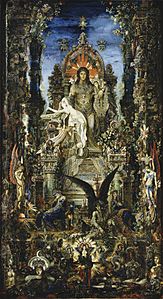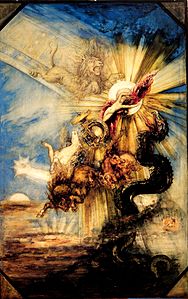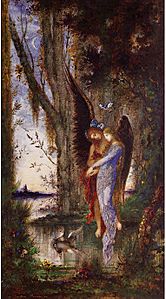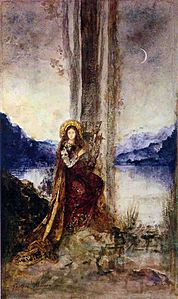Gustave Moreau facts for kids
Quick facts for kids
Gustave Moreau
|
|
|---|---|
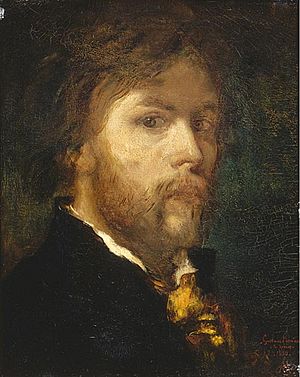
Self-portrait of Gustave Moreau, 1850
|
|
| Born | 6 April 1826 Paris, France
|
| Died | 18 April 1898 (aged 72) Paris, France
|
| Education | Collège Rollin (Collège-lycée Jacques-Decour) Ecole des Beaux-Arts, François-Édouard Picot |
| Known for | Painting |
|
Notable work
|
Oedipus and the Sphinx (1864) L'Apparition (1876) Salome Dancing before Herod (1876) Jupiter and Semele (1894-95) |
| Movement | Symbolism |
Gustave Moreau (born April 6, 1826 – died April 18, 1898) was a French artist. He was a very important person in the Symbolist movement, which was a style of art. Many people called him "the Symbolist painter." He helped start Symbolism in art in the 1860s. By the 1890s, he was one of the most famous Symbolist painters.
Moreau created over 15,000 paintings, watercolors, and drawings. He often painted stories from the Bible and old myths, which were popular subjects in art schools. One writer said Moreau made these old stories feel new and mysterious with his special talent. He often painted women from the Bible and myths. These paintings became symbols of the Symbolist art style.
His art was not very popular in the early 1900s. But starting in the 1960s, people began to see him as one of the most important Symbolist painters.
Gustave Moreau was born in Paris, France. He was good at drawing from a young age. He went to a good school called Collège Rollin. He also studied painting at the Ecole des Beaux-Arts, a famous art school. In the early 1850s, he became good friends with another artist, Théodore Chassériau. Moreau had some success showing his art at the Paris Salon, which was a big art show.
When Chassériau died in 1856, Moreau was very sad. He left Paris and traveled in Italy from 1857 to 1859. There, he copied many old paintings and learned a lot. In 1864, his painting Oedipus and the Sphinx became very famous at the Paris Salon. It won a medal and made him well-known. He continued to be successful in the 1860s and gained many fans.
After 1869, he stopped showing his paintings at the Salon because of harsh criticism. He was given an important award, the Officier de la Légion d'Honneur, in 1883. Moreau became more private as he got older. He did not often sell his work or show it. He even turned down many important offers, like teaching at the Ecole des Beaux-Arts.
However, after his friend Élie Delaunay died in 1891, Moreau agreed to teach at the Ecole des Beaux-Arts. He was a great teacher. Some of his famous students included Henri Matisse and Georges Rouault. Moreau lived and worked in a townhouse in Paris for his whole life. He died in 1898 from cancer. He left his house and all his art to the French government. This became the Musée Gustave Moreau, which opened in 1903. It is still open today and has the largest collection of his art.
Contents
Biography
Early Life and Learning (1826-1856)
Gustave Moreau was born in Paris to a family who loved culture and art. His father, Louis Jean Marie Moreau, was an architect. His mother, Adèle Pauline Desmoutier, was a musician. Gustave was often sick as a child. Around age eight, he started drawing all the time.
His father wanted him to have a good education. So, Moreau learned Greek and Latin. He read many books from his father's large library. He also learned to play the piano and was a good singer. In 1841, he visited Italy with his mother. He filled a 60-page book with drawings during this trip.
Visiting museums in Italy made Moreau want to become an artist. When he came back in 1841, he started taking drawing classes in the evenings. In 1844, he joined the studio of François-Édouard Picot. Picot helped young artists get ready for the art school exams. In 1846, Moreau was accepted into Picot's class at the École des Beaux-Arts.
Moreau hoped to win a big art prize called the Grand Prix de Rome. But he did not make it to the final rounds in 1848 and 1849. So, he left the École des Beaux-Arts early. His art style soon became different from what the school liked. But he still used many of the basic art methods he learned. He also stayed focused on painting historical and mythological scenes.
Moreau spent time copying paintings at the Louvre Museum. He became interested in romanticism, an art style. He admired two artists, Eugène Delacroix and Théodore Chassériau. Chassériau was seven years older than Moreau. He became a good friend and mentor to Moreau. Moreau rented a studio near Chassériau's. During this time, Moreau enjoyed going to the opera and theater.
In 1853, Moreau's father bought a townhouse. He turned the top floor into a studio for Moreau. Moreau lived there with his parents for the rest of his life. Moreau started a huge painting called The Suitors (1852–1896). He worked on it for many years, but it was still not finished when he died.
Moreau began showing his art regularly in the 1850s. He got some painting jobs from the city with his father's help. He showed his art at the Paris Salon for the first time in 1852. His painting Pieta was bought by the state. In 1853, he showed two more paintings. One of them, Song of Songs, was also bought by the state for a museum. In 1855, another painting was bought for a museum.
In 1856, his friend Chassériau died at age 37. Moreau was very sad. He started a painting called The Young Man and Death in 1856, finishing it in 1865. He dedicated it to Chassériau.
Early Paintings
-
Song of Songs (1853)
-
Pietà (1854)
Travels in Italy (1857-1859)
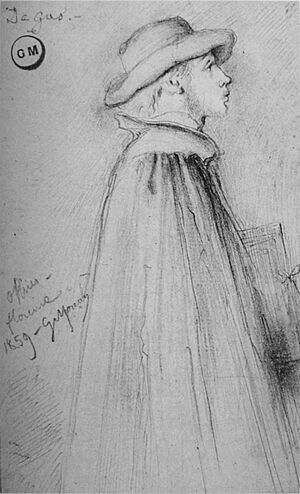
After Chassériau's death in 1856, Moreau was very sad and stayed away from people. His parents suggested he travel to Italy again. In Italy, he found his love for art once more. He was inspired by famous Italian Renaissance artists like Leonardo da Vinci and Michelangelo.
Moreau went to Italy in October 1857 with his friend Frédéric Charlot de Courcy. He saw this trip as a chance to study more art, since he had left art school early. He spent many hours copying figures from the Sistine Chapel ceiling. He copied works by both famous and lesser-known artists. He was especially interested in how artists grouped many figures and used colors.
He also went to the Villa Medici, where he could draw live models. There, he met other artists from Paris, including a young Edgar Degas. Moreau became a mentor to Degas while they were in Italy. In August 1858, Moreau's parents joined him. His father, who had just retired, was very interested in the buildings. In Venice, Moreau became fascinated with Vittore Carpaccio, an artist who was not well-known at the time. He copied several of Carpaccio's works. They also visited other Italian cities like Florence and Milan.
Moreau mostly copied other artists' work in Italy. He created only a few original pieces there, like some large drawings and beautiful watercolor landscapes. In September 1859, Moreau and his parents returned to Paris with hundreds of drawings and paintings. Back in Paris, Degas painted a small portrait of Moreau in 1860. This portrait stayed in Moreau's studio for the rest of his life. However, their friendship changed as Degas became interested in impressionism, while Moreau focused on historical paintings.
Success and Later Career (1860-1880)
Moreau never married. He had a very close friend named Adelaide-Alexandrine Dureux for over 30 years. Moreau drew and painted her many times. Their friendship was very private. His mother also liked Alexandrine. Moreau designed Alexandrine's tombstone, which had their initials, A and G, carved into it. It is near his family's burial place.
His painting Oedipus and the Sphinx won a medal at the Paris Salon in 1864. This painting showed his careful study of artists like Vittore Carpaccio and Andrea Mantegna. Its clear lines and detailed style were typical of the works that made him successful. Moreau quickly became known for his unique style. One person said his work was like a mix of old masters and deep philosophy. This painting is now in the New York Metropolitan Museum of Art.
In the 1870s, Moreau stopped showing his art for a few years. He wanted to try new things because some critics said his work was becoming too similar. In 1876, he finished Salome Dancing before Herod. This painting showed a new, more colorful style that he would use later.
He received another important award, the Chevalier de la Légion d'honneur, in 1875. He was promoted to Officier de la Légion d'honneur in 1883.
Teaching and Final Years (1881-1898)
Moreau became more private as he got older. He stopped showing his art at the Salon and refused to show it abroad. But he still painted a lot. He sometimes had visitors at his home, and he was known for his interesting conversations. However, he rarely let visitors see his studio. He was very educated and read many books. He lived a simple life compared to other successful artists in Paris.
In 1879, an art collector asked several artists, including Moreau, to create works based on Jean de La Fontaine's Fables. Moreau created 25 pieces, more than anyone else. His work was considered much better than most of the others. He was the only one asked to continue the series. In 1886, 64 of his La Fontaine fables and six other large watercolors were shown at the Goupil & Cie Gallery. This was the only private show of his work during his life. Sadly, nearly half of these paintings disappeared later and have not been found.
Moreau and his mother were very close. When she lost her hearing, he wrote notes to her about his paintings. His assistant saved many of these notes, which now help us understand Moreau's ideas. His mother died in 1884 at age 82, and he was very sad. He could not sleep alone in the house for a while. Six years later, his close friend Alexandrine Dureux died in 1890. Her death also affected him deeply. He bought back some of the watercolors he had given her and placed them in a room in his home to remember her. These deaths made him feel even more alone. He focused on his work, which became more sad.
Moreau was asked to join the École des Beaux-Arts in 1888. But he said no to being a professor. However, his friend Jules-Élie Delaunay asked Moreau to take over his art class at the school when he was dying. Moreau agreed to teach the class in October 1891. He became a full professor and studio director in January 1892, at age 65.
Moreau was a very different kind of teacher from others at the École des Beaux-Arts. About 125 students studied in his studio between 1891 and 1898. Some of his famous students were Henri Matisse and Georges Rouault.
Moreau was an amazing teacher in his last years. His class quickly attracted the most creative students. He did not force his own style on them. Instead, he encouraged them to find their own ideas. He took his students to the Louvre Museum to study old master paintings. This was unusual for the art school. Matisse said it was "almost revolutionary" for Moreau to show them the museum. Moreau also invited students to his home on Sundays.
Georges Rouault said Moreau was "not a professor in the usual sense, but a man whom it did you good to emulate." Rouault always respected Moreau deeply. Matisse said Moreau's great quality was helping young students grow throughout their lives. Matisse himself was not allowed into the École des Beaux-Arts at first. But Moreau saw him drawing and invited him to join his class without an exam. Matisse became a leader among students who later started the Fauvist art movement. Moreau's students often remembered his wise words, like "One must think color, one must have it in the imagination."
Moreau started worrying about what would happen to his art in the 1860s. He began listing his paintings around 1884. The death of his friend Delaunay in 1891 showed him what could happen to an artist's work after they died. Moreau decided to leave his house to the state as a museum. He changed his townhouse in 1895, making his small studio into a much larger exhibition space.
After being sick for about a year, Moreau died of stomach cancer on April 18, 1898. He was buried in Paris in his parents' tomb. He asked that his death not be announced in the news. He wanted a very small funeral. He also asked that any flowers be placed on Alexandrine Dureux's grave, not his own. The government was not sure about taking his house as a museum. Artist house museums were very rare in France then. His assistant, Henri Rupp, helped organize everything and convinced the state to take it over.
Art
Unique Style
Gustave Moreau learned classical drawing, but he also liked to try new art styles. He traveled to places like Italy and read many books about art and history. These influences helped Moreau create his special kind of art. He drew not only people but also animals and old buildings. He started by drawing classical art. But by adding exotic images, he made his art mysterious and unique.
Legacy
During his life, Moreau created more than 15,000 paintings, watercolors, and drawings. He did not like to sell his work. So, when he died, he still owned 1,200 paintings and watercolors and 10,000 drawings. He left all of them to the state. The Musée national Gustave Moreau opened to the public on January 14, 1903. His former student, Georges Rouault, became its first director.
Moreau had a huge influence on Symbolism during his life and after his death. He was seen as a Symbolist even before the movement became popular. He influenced other Symbolist artists, especially in Belgium and France.
Many poets and writers admired Moreau's paintings. It was common for poets back then to write poems about paintings they liked. Moreau's paintings were among the most praised by Symbolist poets.
Interest in his work stayed high for about 10 years after his death. But when the museum opened, some people were disappointed to see many drawings and unfinished paintings instead of only famous finished works. Attendance at the museum started to drop. As new art styles like impressionism and cubism became popular, Moreau's art seemed less modern and was almost forgotten. After World War I, Moreau was mostly known as the teacher of Rouault and Matisse.
Moreau and Surrealism
André Breton, a famous artist who started Surrealism, loved to visit the Moreau museum. He saw Moreau as someone who paved the way for Surrealism. In his Manifesto of Surrealism, Breton listed artists who "could pass for Surrealist," and Moreau was among them. Breton wrote in 1961 that discovering the Moreau Museum when he was 16 changed his life. He found beauty and love in the faces of women in Moreau's paintings. Salvador Dalí, another famous Surrealist, also admired Moreau's work and visited the museum often. Dalí even chose the Moreau Museum in 1970 to announce his plans to open his own museum.
André Breton promoted Moreau's work throughout his life. He introduced other writers and artists to the museum. In 1958, when Moreau's art was largely forgotten, Breton helped organize an exhibition of Symbolist drawings. This exhibition helped bring attention back to Moreau's work. In 1961, both the Louvre Museum and the Museum of Modern Art held exhibitions of Moreau's paintings. This led to more exhibitions and books about Moreau and Symbolism.
The Japanese artist Yoshitaka Amano, known for works like Final Fantasy, was inspired by Moreau's style. Amano said he tried to copy Moreau's works when he was trying to find his own art style.
Gallery
Oil paintings
-
The Triumph of Alexander the Great (around 1885)
Watercolors
-
Salome in the Garden (1878)
See also
 In Spanish: Gustave Moreau para niños
In Spanish: Gustave Moreau para niños
- L'Apparition
- Les Chimères (painting)
- La Sirène et le Poète (French)





